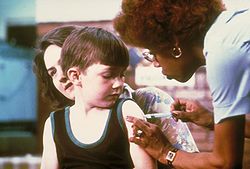Vaccines
Types of vaccines[edit | edit source]
Live (attenuated) vaccines[edit | edit source]
→ modified strains Vaccination, live, laboratory propagated viruses, or bacterias. The oldest type of vaccine. E.g.: measles, mumps, rubella, poliomyelitis, TBC, yellow fever, typhoid fever
Killed (inactivated) vaccines[edit | edit source]
→ purified suspensions of killed (disease-free) viruses or bacteria.
E.g.: whole cell vaccine against whooping cough, polio vaccine type, tick-borne encephalitis , HAV
Anatoxins[edit | edit source]
→ bacterial toxins do not harm but stimulate the production of antibodies.
E.g.: tetanus, diphtheria
Subunit and cleaved vaccines[edit | edit source]
→ vaccines prepared by decomposing the virus into smaller particles by purifying and concentrating them.
E.g.: vaccine against flu
Polysaccharide vaccines[edit | edit source]
→ are prepared by concentrating the active ingredient, the bacterial surface polysaccharide.
E.g.: meningococcal, hemophilic and pneumococcal infections
Recombinant vaccines[edit | edit source]
→ modern vaccines. They are prepared by introducing Genes encoding the production of vaccine particles into yeast, certain bacteria or tissue cultures, which then themselves produce the particles needed to develop immunity.
E.g.: HBV, Papillomavirus infections
Perspectives in the development and use of vaccines[edit | edit source]
Despite intensive vaccine development, vaccines against infections caused by antigenically more complex agents, such as parasites, yeast and mycoplasmas. Further against AIDS, malaria, lyme disease, herpes infections, rotavirus infections, papillomaviruses or better influenza vaccines, TB or cholera.
Combined vaccines are considered to be the most promising for future use. You should provide immunity against several infections at the same time. Highly effective (long-term, lifelong immunity), no side effects, easy to apply (per os), one max. Two doses, highly stable and affordable.
Dynamics of antibody production[edit | edit source]
Seroconversion = induces the synthesis of detectable antibodies after administration of the vaccine.
Primary response= after the first administration of an antigen with which the organism has not yet encountered, antibodies of the IgM, IgG class are applied.
Anamnestic reaction
Booster effect
Methods of vaccine application[edit | edit source]
Intramuscular → in children up to 2 years of age, to the anterolateral side of the thigh, deltoid muscle, to gluteus muscle - most vaccines
Subacute → anterolateral side of the shoulder or thigh
eg: measles, mumps, rubella, yellow fever vaccine, Rabies
Intradermal → TB vaccination only (left shoulder skin)
Oral → live vaccine against Poliomyelitis, certain vaccines against cholera and typhoid fever,
this method is considered to be the most promising
Links[edit | edit source]
Related articles[edit | edit source]
- Active immunization
- Passive immunization
- Simultaneous combined immunization
- Specific immunity
- Non-specific immunity
- Vaccination breakdown in the Czech Republic
- Regular vaccinations in the Czech Republic (vaccination calendar)
Bibliography[edit | edit source]
- GÖPFERTOVÁ, Dana. Epidemiologie. 1. edition. Karolinum, 2006. ISBN 80-246-1232-1.

